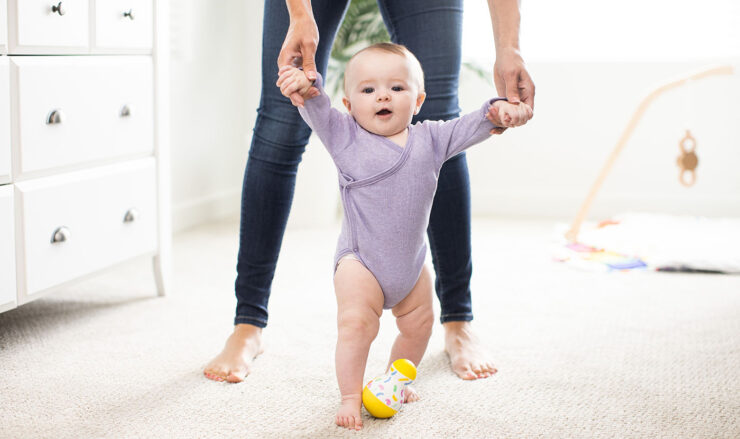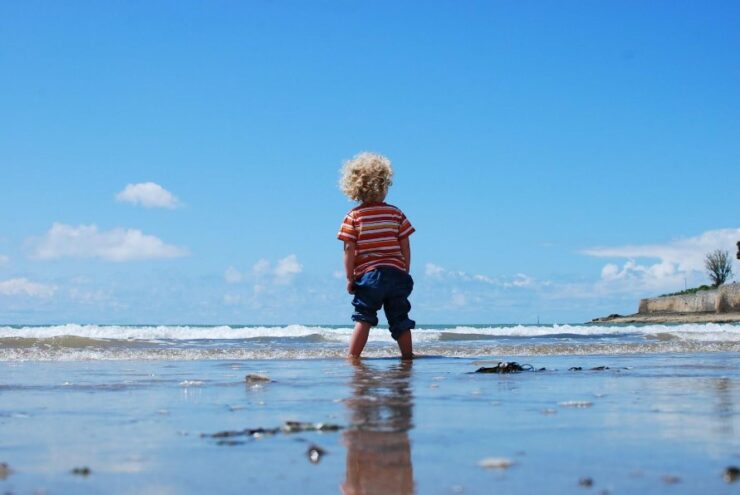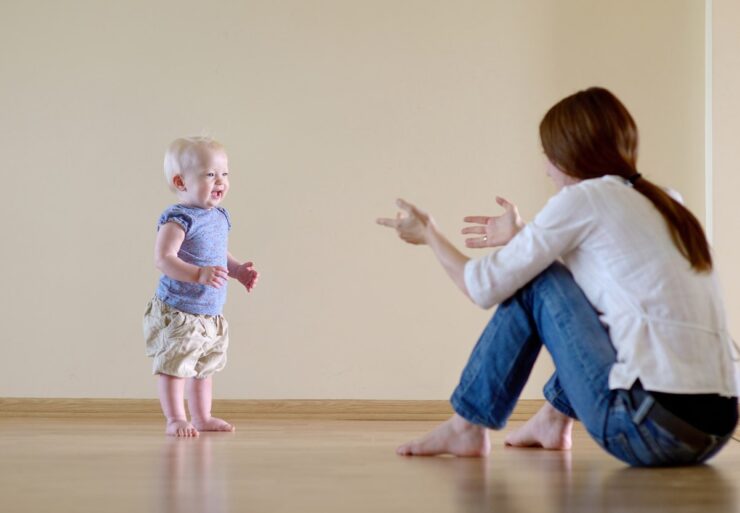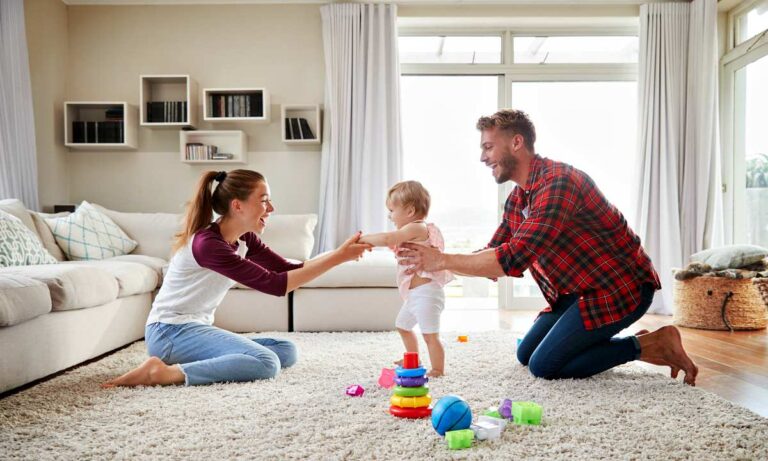Walking is a skill that almost every child will learn at some point. Unless they are having difficulties for other reasons, at some point, your child will take their first steps and never look back.
However, if you want to help them along, help them build strength and get them going on the right foot, get the boy’s or girl’s trainers out on websites such as Bobux. Here are some of the best ways to help your child begin to walk.
Sitting
While sitting is clearly not walking, it is an essential step in the walking process. Sitting requires core strength and balance, two things needed for walking. When your child is sitting, sit with them and play.
The goal here isn’t to get them to stand up right away but to instead have them sit for an extended period to build this strength and balance.
Encourage Crawling

Crawling is the next step towards walking, and while your child will scoot along the floor just fine, you may want to encourage it more to build leg strength. Once again, weak legs won’t help with walking, and building movement and muscle in them definitely helps.
Standing Play
Standing will begin at some point, and just like with sitting, you should take this opportunity to sit with your child and play games and have fun with them while they stand. This lets them build their leg strength even more and is much closer to walking than crawling.
Standing play will also help encourage cruising, something we’ll talk about next, and possibly even taking a step or two. Standing is easier than taking a step but holding themselves up is a necessary step.
Let Them Pull and Hold
Once your child gets more comfortable with standing, they are going to want to do it all the time. They will use any surface, whether it be a table or couch, or anything they can hold onto to help themselves up.
Unless they can hurt themselves, the best thing to do is to leave them be. The more your child does this, the strong their upper body and legs will get.
Cruising

Cruising is when a child uses a couch or table to shuffle along the side of it. It is the last phase before proper walking, and you should let your child do it as much as possible. While you can obviously play with your child while they do this, let them shuffle back and forth as much as they can.
Push-Toys
Push toys are another great way to get your child to walk in a fun way. They provide just enough stability without being a crutch, and they allow your child to pick up some speed and run to a degree.
Avoid Walkers
Walkers that your child can sit in may seem like a good idea. They can move around easily, your child can’t fall over and hurt themselves, and they also allow them to bump into walls or tables without breaking anything.
The biggest problem with these walkers is that your child doesn’t stand or walk enough; they have too much help from the walker. They won’t build the strength or balance they need, and it can take much longer for them to begin to walk.
Encourage Movement

Encourage your child to move as much as possible, don’t jump to pick them up immediately or help them along; let them do it themselves, no matter how long it may take. They will also not get tired as quickly as you think, and when they are, you will know.
Standing Without Help
You may be tempted to help keep your child standing when they begin to take a step or two and fall over. While you may want them to start walking, it is also ok if they fall over a few times because they just aren’t ready yet.
If they get up and fall down 30 times in a row, let them, they will get the hang of it eventually and will know what to do to keep their bodies up, to step, move, etc.
No Shoes

While your child should wear shoes outside, they can actually be a detriment to their walking. Babies have little to no muscle tone and strength across their entire bodies, and shoes hinder the development of muscle tone in their feet.
If it’s really cold or you have slippery floors, you can put non-slip socks on them, but rather keep them barefoot or without shoes as much as possible. Even when you go out to a park or the beach, get their shoes off as soon as possible and let them walk or shuffle like that.
Be Patient
The last thing you need to do is be patient. As mentioned, unless your child has difficulties you aren’t aware of yet, they will learn to walk eventually. Some children begin to walk much sooner than expected, while others will take much longer.
Either way, your child isn’t going to just crawl forever, and before you know it, they will be up and zooming and will never crawl again.
Exercises To Help Your Child Walk

Seeing your child take his first steps is a milestone for every parent and it is the most exciting thing to witness. A child after being born goes through numerous development stages such as sitting, crawling, walking, etc. Though, as a parent, you should know that all children are different and that not all of them will go through these phases at the same time.
Some start walking early whereas some take some time to learn to walk. Having said that, if your baby is having a hard time learning to walk, we have got you covered. In plenty of ways, you can help your child get on the journey to walk with greater ease.
Let’s go over a few exercises that you can do along with your child to help them learn to walk easily.
- Cruising: Let your infant cruise back and forth along with a sofa or a side bench. This will help them learn to walk quickly. Make them stand by the sofa and allow them to hold it with one hand. Hold their other hand so that they get to balance. Allow them to practise walking by walking back and forth along with the furniture. If the infant is not showing any signs of trying to walk, maybe try giving an incentive. Place their favourite toy on the other end of the sofa so that they start walking.
- Assisted Walking: We all have seen a lot of parents do this, even our parents must have done this when we were infants, to help us learn to walk. Stand behind your child, and hold their hands from behind by placing your hands on their upper arms. This way the baby will stand in front of you. Place both their legs on yours and then walk. Keep practising in this way until your baby is ready to stop.
- Cruise and Kick: Another easy and popular exercise that helps parents teach their kids to walk. We just saw the cruising exercise, when the baby is holding the furniture while cruising, keep a foam ball on the floor next to your child. The ball may get kicked by their feet accidentally, but you should keep placing the ball again and again there. At one point, they will surely lift their leg to kick the ball purposely. To make them practise kicking with both feet, place the balls on both sides.
You need to be mindful when making your kid learn to walk. That said, they should not get hurt and you need to encourage safe walking. Work on their strengths and sportingly address their weaknesses. Try to work with them when they are on their learning journey.
Conclusion
Ready or not, at times your baby may start walking even before you know it. If you see that even after 12 months, they are showing no signs of getting up and walking, teach them. A few activities done with them will help your baby learn to walk. You should always be present around them to support their body in these new ways.

